







Silent Swarm
Powermaster


2.Sheridan
3.Crosman
fixed brace

2.Sheridan
3.Crosman
folding brace


Mulders








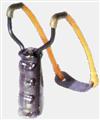


/Strike9 1st Gen.

/Strike9 2nd Gen.
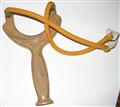

Bobcat?


(small)

(large)




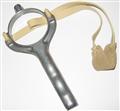

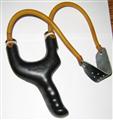
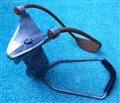
G-String



Marketing


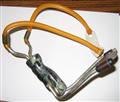





shooter
Hy-Power
(dedicated page)
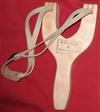

















The following list is an attempt to assemble a comprehensive collection of vintage slingshots. Please note that much of the information - especially the production dates - is very vague. Finding hard data is difficult with slingshots, as they are typically produced without the documentation of, say, a car or a firearm.
| Picture | Manufacturer | Model name | Production date | Country | Further Info |
|---|---|---|---|---|---|
 |
The Southern Armoury | - | 1920s | UK | Yes |
 |
Frank Dyke and Co | Deadshot | - | UK | Yes |
 |
The Modern Arms Co | Ejex | before 50ies? | UK | Yes |
 |
Thomas Salter | Thomas Salter catapult | until 1980ies | UK | Yes |
 |
- | Goliath | ca 1920ies | UK | Yes |
 |
- | Silver Shot | - | UK | Yes |
 |
Wham-O | Sportsman | 1948-1970 | USA | Yes |
 |
Crosman | Desert Scout Silent Swarm Powermaster |
-2009 | USA | Yes |
 |
Nichols | Super Sling Shot | 1951 | USA | Yes |
 |
1.Wham-O 2.Sheridan 3.Crosman |
Powermaster fixed brace |
- | USA | Yes |
 |
1.Wham-O 2.Sheridan 3.Crosman |
Powermaster folding brace |
- | USA | Yes |
 |
- | Zip Zip | 1918 | - | Yes |
 |
Hodge Mulders |
Catapull | 1948(pat.) | USA | Yes |
 |
Victor | 10 | - | USA | Yes |
 |
Victor | 20 | - | USA | Yes |
 |
Milbro | Milbro | - | UK | Yes |
 |
Milbro | Special offset thumbgrip | - | UK | Yes |
 |
Tinker | Killdeer | - | USA | Yes |
 |
Tinker | Deerslayer | - | USA | Yes |
 |
Barnett | Diablo 1st Gen. | - | UK | Yes |
 |
Barnett | Diablo 2nd Gen. | --2005 | UK | Yes |
 |
Barnett | Sidewinder | - | UK | Yes |
 |
Barnett | Cobra 1st Gen. | ?-2000 | UK | Yes |
 |
Barnett | Black Widow /Strike9 1st Gen. |
?-2000 | UK | Yes |
 |
Barnett | Black Widow /Strike9 2nd Gen. |
2000-2005 | UK | Yes |
 |
Weber | Slingbow | - | USA | Yes |
 |
Weber | Lynx? Bobcat? |
1978(pat.) | USA | Yes |
 |
Weber | Cat? | 1970s | USA | Yes |
 |
Milligan | Milligan special (small) |
1950s | USA | Yes |
 |
Milligan | Milligan special (large) |
1950s | USA | Yes |
| - | Saunders | Wrist Rocket | - | USA | - |
| - | Saunders | Falcon | - | USA | - |
| - | Saunders | Falcon 300 | - | USA | - |
| - | Saunders | Double Eagle 1st Gen. | - | USA | - |
| - | Saunders | Hawk 1st Gen. | - | USA | - |
 |
Marksman | Fireball | - | USA | Yes |
 |
Marksman | long | - | USA | Yes |
| - | ? | Silent Slim | - | USA | - |
 |
? | Davy Crockett | 1950(pat.) | USA | Yes |
 |
? | AERO-Sling | - | USA | Yes |
 |
General Sports | Scopeshot | - | USA | Yes |
 |
? | Little David | - | USA | Yes |
 |
Boler Mfg. | Boler | 1964(pat.) | USA | Yes |
 |
Magda | DingDong / G-String |
- | ? | Yes |
 |
? | Bullseye | - | ? | Yes |
 |
Lohman | Lohman | - | ? | Yes |
| - | - | Sling-O-matic | - | ? | - |
 |
Lighthouse Marketing |
Nightstalker | 1980s | USA | Yes |
 |
A.S.C | Blackhawk | - | 1960s | Yes |
 |
Glatz | Zwillengabel | pre 1945? | Czech Rp. | Yes |
 |
? | Pocket Rocket | - | USA | Yes |
 |
Wham-O | Sharpshooter | 1950s | USA | Yes |
 |
? | Bungay | - | UK | Yes |
 |
? | TSL | - | UK | Yes |
 |
? | Warden | - | UK | Yes |
 |
? | Slingo | 1935 (pat.) | USA | Yes |
| - | ? | Little Oscar | - | ? | - |
| - | Beeman | Ninja | - | ? | - |
| - | ? | Perfect Grip | - | ? | - |
| - | ? | Sure-Shot | - | ? | - |
| - | ? | Texas Rabbit shooter |
- | ? | - |
| - | ? | Target King | - | ? | - |
| - | ? | Zip-Liner | - | ? | - |
| AKAH | Zwille/ Hy-Power |
- | ? | Yes (dedicated page) |
|
 |
Delong | Ranger | - | ? | Yes |
| - | Thoreses | Extra Power | - | ? | Yes |
| - | ? | Huck-Finn | - | ? | - |
| - | ? | NFI | - | ? | Yes |
| - | Lukens Aluminum Corp. | Lukens | - | USA | - |
 |
A.F.I | Super | - | USA | Yes |
 |
- | Deadeye | - | USA | Yes |
 |
- | Super Sight | - | USA | Yes |
 |
Spanter | Junior | - | Germany | Yes |

The Wham-O Sportsman is, without doubt, the most famous
vintage US-made slingshot. It was introduced during the 50's as the
first product of the toy maker Wham-O, and was marketed together with
the National Slingshot Association. In the 60s, the popularity of
slingshooting had reached a peak that was never exceeded until today,
and the Wham-O was tremendously successful. One might wonder why this
relatively simple slingshot became the big hit - it is said that it had
excellent Gum Rubber flat bands, and the sale connection with the NSA
were certainly helpful, too. Anyway, it sparked the production of many
Clones that tried to emulate the simple, yet functional frame, and use
flat gum rubber bands as well.
The Wham-O Sportsman has a sawed-out hardwood frame with two slits on
each limb to hold a flat rubber band. It was said to be quite powerful,
and was often used for hunting. The large cowhide pouch could be used
to shoot several pellets shotgun-style, although I doubt that this
approach to increase hit probability was a big success. One could add a
steel wire rest to the fork, making it possible to fire arrows.
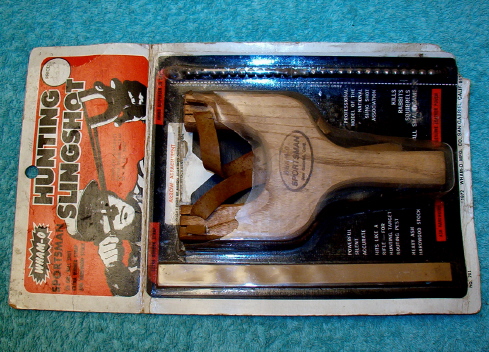
Complete Wham-O shopping box with ammo and spare bands.
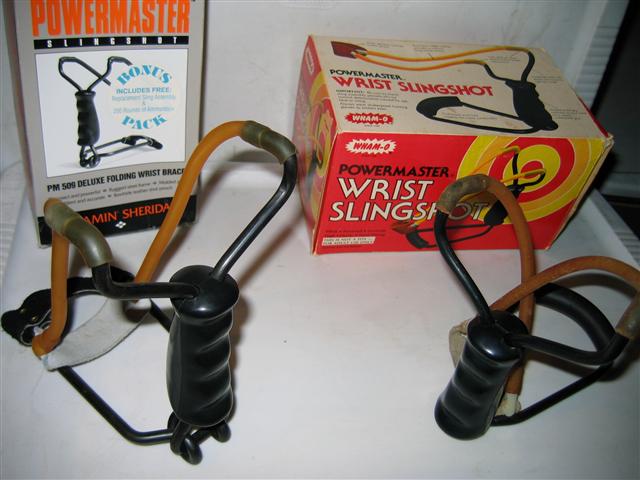
In the 50's to the late 60s, Wham-O had tremendous success with its wooden "Sportsman" model. But the introduction of modern slingshots with wristbraces and mass-producable bent-metal frames marked the end of the vintage slingshot era. The Powermaster was Wham-O's answer. Two versions existed: One had a single metal part that ran through the handle to form both fork and wristbrace. The other one was a folding slingshot with two metal parts that form a hinge where they meet.
At some point, Wham-O decided to sell off the design. The very same slingshots were then produced by the famous airgun maker Sheridan, who, in turn, was bought up by Crosman, where the "Powermasters" were sold as the fixed "Cyclone" and the other model served as the basis for the folding "Desert Scout" and "Powerstorm". Crosman ceased slingshot production in 2009, thus putting an end to these venerable slingshots.


The Crosman slingshots developed from the Wham-O Powermaster
model. Eventually, Wham-O decided to focus on non-dangerous toys, and
sold their design to Benjamin Sheridan. Sheridan was purchased by
Crosman, so Crosman ended up with a slingshot production.
The basic metal frame of the Wham-O Powermaster was never changed.
Crosman did some modifications to the handles and later introduced
tapered bands. They also changed the names of the models several times,
which often leads to confusion among collectors.
The "Desert Scout" was a folding slingshot with wristbrace. The same
slingshot was sold without brace as "Silent Swarm". A deluxe version
with padded handle and an ammunition dispenser was called the
"Powerstorm", and later was renamed to "Firestorm". Crosman ceased
slingshot production in 2009. Their latest slingshots were plaqued by
massive quality issues due to poor work by their Asian contractors.

The Zip Zip was made in 1918 and is currently be the oldest
comercial slingshot known to the collectors community. It is preceded
by a number of slingshot patents that reach back to 1890 and earlier,
but no existing slingshot from that time is known, while the Zip Zip is
not as rare as one might believe.
The slingshot's frame is cast iron, with a number of ribs on the fork
ends. A 1918 patent of a slimilar slingshot
suggest that the slingshot used flat bands that were attached "over the
top", with twine and pieces of rubber tubing holding the bands in
place. The slingshot reads "Zip Zip" on the front and "Pat. D. 1918" on
the rear side.
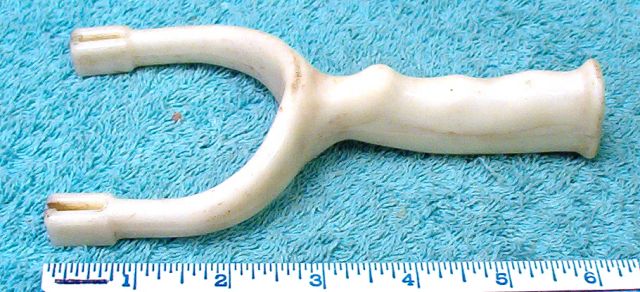
Victor Model 10
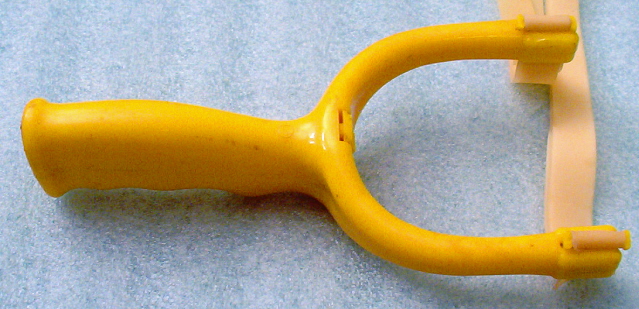
Victor Model 20
Victor Animal Trap Company produced two slingshots with the intention to sell them to trappers who have the need to kill a trapped animal with a shot from short distance. This is usually done with a smallbore firearm, but a slingshot is less expensive and can be used in inhabited areas without disturbing the residents. Both slingshots are molded plastic and have a contoured grip. They accommodate flatbands with the "Matchstick method", using two dogbone-shaped plastic wedges. The original bands were made of white gum rubber. The Victor 10 is so small that its handle seems to be tailored to a child's hand. Model No.20 has the same shape, but is bigger and has a small ammunition reservoir with sliding door at the base of the yoke. Both slingshots are sought-after prized collector's items, and are generally seen as well designed and comfortable to hold. The Victor 20's shape is very similar to the Hodgon/Mulders Catapull.
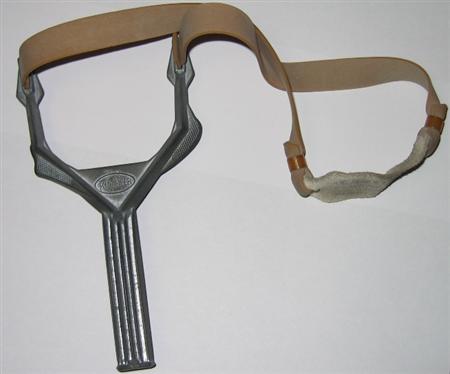
Tinker Killdeer with original bands
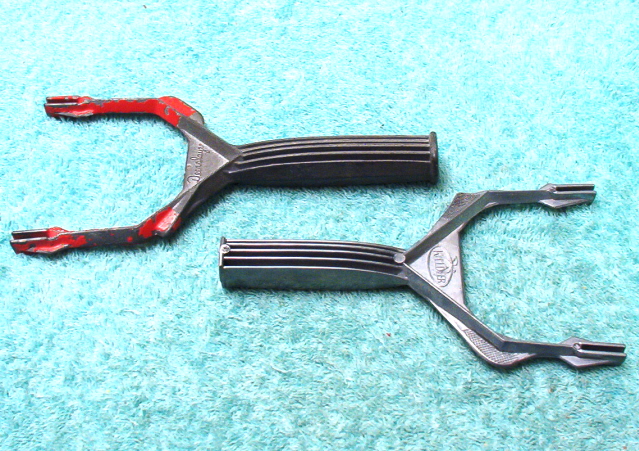
Tinker Deerslayer (top) with Killdeer
Carl Tinker, a retired engineer, from Lapeer,
Michigan, produced the Tinker from the 1950s to the 70s with a
remarkable home-made metal molding machine. Two similar designs - the
Killdeer and the slightly larger "Deerslayer"- exist, the Deerslayer
being a lot rarer than its smaller brother. The Tinkers are made from a
magnesium alloy and used gum rubber bands that were connected to the
pouch using Scotch tape. The frames have tape prodtruding on the sides
of the fork, that are meant to support thumb and index finger. It was
sold with an extra band assembly and different types of ammo. The fork
ends of most Deerslayers are painted red.
Carl Tinker was a slingshot enthusiast, and his knowledge payed off
well. The Killdeer is, in my opinion, one of the most comfortable
slingshots ever designed.
Further Information: Story
about Carl Tinker
More
background and an advertisement flyer

The "Sidewinder" was simple slingshot that can store
ammo in its handle. I've never seen one except on a webpage of Barnett
USA (around 1995-2003), and not a single webshop offered the
Sidewinder. It makes me wonder if this slingshot was actually sold.
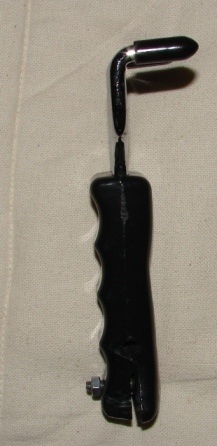
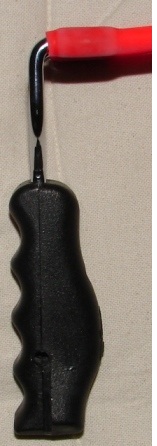
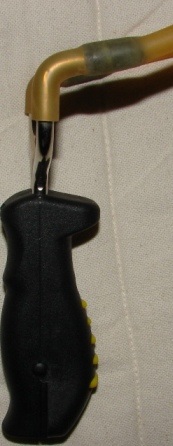
Three versions of the Strike9 / Black Widow exist. The metal fork remained identically, but the handles changed. The last version is in production.
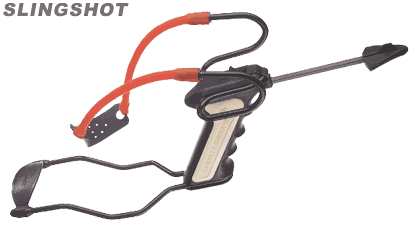
The old version of the Barnett "Cobra" that was replaced around 2005
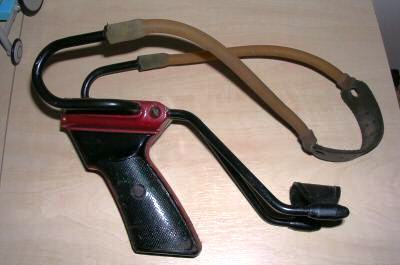

The first Diablo had a cast metal frame with two plastic grips. The second version had a one-piece handle that looked like a wood/epoxy mix. Both slingshots accomodated a sight and stabilizers, this was called the "Pro Diablo"

The Weber Tackle Company, Stevens point, Wisconsin, produced this famous slingshot. The frame is molded from high-impact plastic, and gum rubber tubing. The bands are attached to aluminium prongs which go through the forks and are attached with a nut.


In 1976, the famous slingshot Inventor Rodney Wolf entered the Weber Company. Wolf was a passionate slingshooter, and he made many experimental designs that led to a series of highly advanced slingshots that were named after feral species. They all had a fork that was tilted 45?to the side and used thin, tapered bands that were attached on rotating studs, thus giving the shooter a high degree of performance and band life. The "Cats" had a fork that was either made from flat metal or late from bent rods. The slingshots were either equipped with a wristbrace or with a leather strap. There is some comfusion about which name belongs to which version, but one thing is sure: The "Cats" are among the highes sought-after collectors slingshots, and are very well made and advanced designs.
Rodney Wolf's tapered band patent
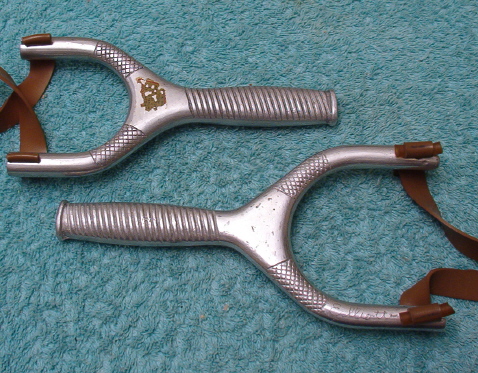
The famous Milligan special was designed by expert shooter John "Slingshot" Milligan in Detroit. It was produced in the 50's and was avaliable in two sizes. Both were cast out of aluminum alloy. This slingshot is an all-time classic, and a pleasure to hold and shoot.
Story about the Detroit slingshooters

The Davy Crockett had a very simple bent-wire frame and sighting device on top. The bands were mounted on the sighting part that could swivel in its horizontal axis, to keep the sights always in line with the bands.
Patent of the Davy Crockett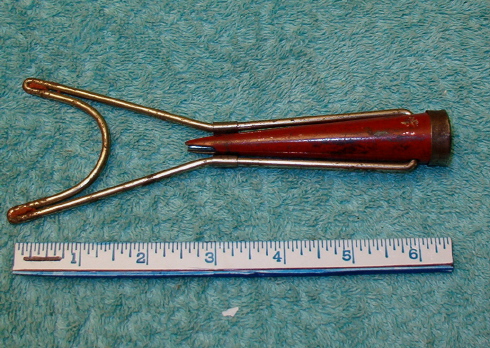
The Slingo was a simple slingshot made of bent steel wire in 1935. The cone inside the handle held BBs as ammo and could be turned upside down to release its content. With these light projectiles , crude shape and a relatively weak rubber band, this model was made for children and plinking in mind.
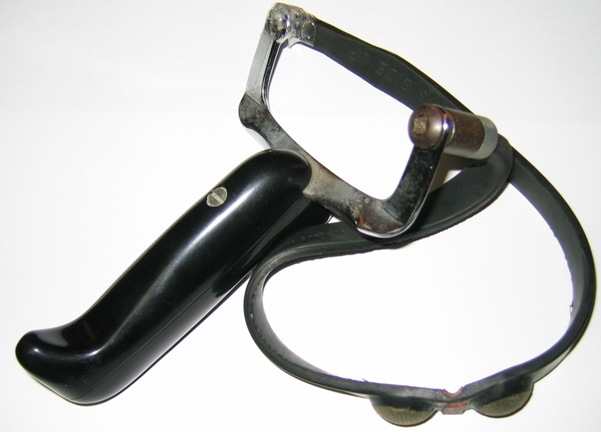
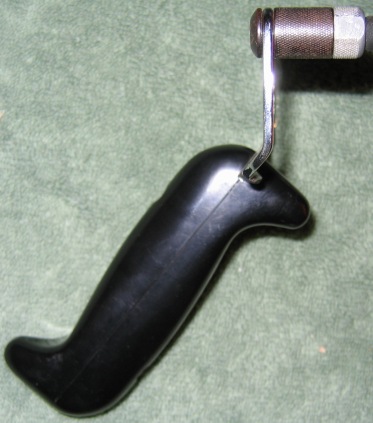
The "Blackhawk" is quite an interesting slingshot that was produced by the American Slingshot Company (ASC) from Toledo, Ohio around 1964. As you can see, it doesn't use a traditional band asembly with leather pouch, but instead has a molded cup on each side of its bands. The intention was to either load one large steel ball or fill it with shot. The Blackhawk's bands are so strong that it hurts the wrist to use it. It obvously was intended to be used for hunting, although the effect of a shot load from a slingshot is definitely not enough for this purpose.

This cast metal slingshot was made from 1948 on. It
was patented by Mr. Hodge who also produced it for some time, until the
company "Mulders" purchased the rights to make them. The "Victor 20"
looks so similar that I believe it is also based on this slingshot.
The Hodge has a well designed pistol grip that sits at a slight angle
towards the fork. Have a look at the box - the original bands were
attached with rivets, probably to cut down work time. I don't think
this was good for the bands.

A small cast metal slingshot that appears to have used solid bands with stopping pieced molded on at the end.
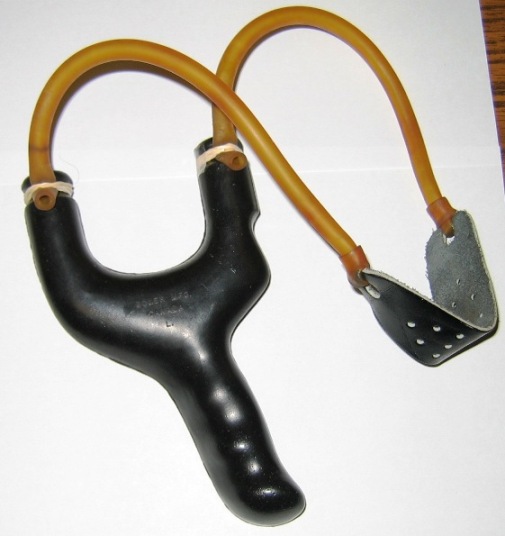
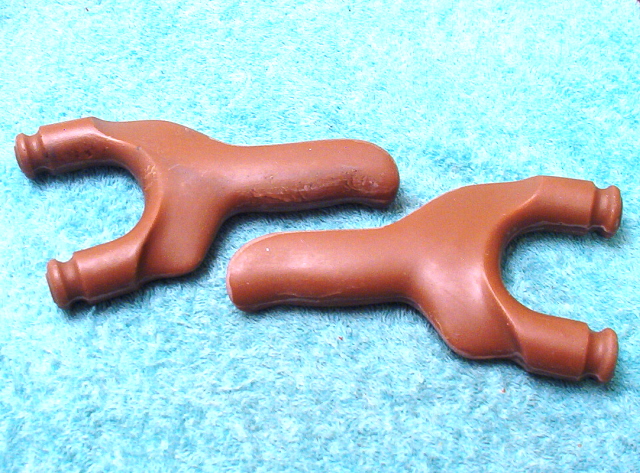
The Boler is a remarkable slingshot. Most slingshots
align for and handles in some type of geometrical pattern. Not so the
Boler: The Designer put a lot of effort into designing an "organic"
ergonomical slingshot that has an offset handle and a deep groove in
the rear to fit the webbing between thumb and index finger. The
slingshot is made of resin and is one of the first to attach its bands
in an "over the top" fashion. Two strips of sticky latex came with the
Boler, they were used to tie the bands to the fork. Both a left- and a
right-handed version were made. It seems that the inventor made his
homework - even today, shooters praise this slingshot as very
comfortable and well designed.
Boler
patent
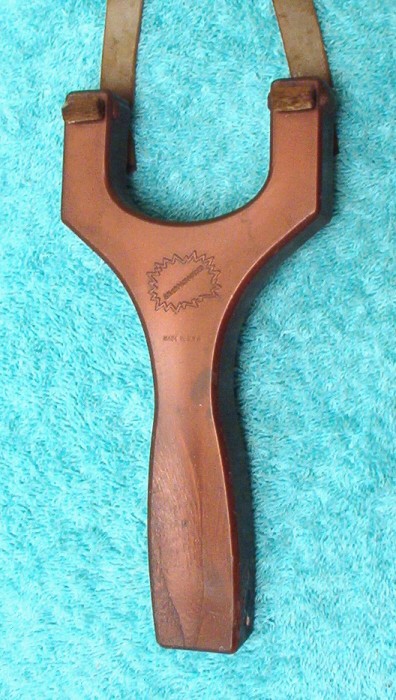
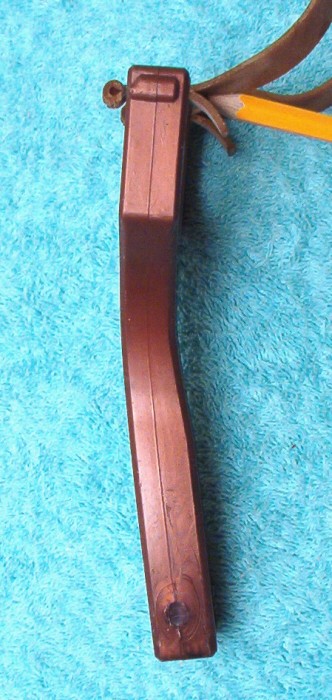
The Sharpshooter was made in 50's, and it is said it
was made in
Beeville, Texas. The sharpshooter has a raised "Sharpshooter" logo on
one side and a "Wham-O" logo on its opposite side. Wham-O is much
better for its famous "Sportsman" wooden slingshot that was also
manufactured during the 50ies.
The Sharpshooter's frame was made of plastic and had quite an
interesting way of attaching the bands: They were simply pushed in
slot-like holes. The slingshot was shot "over the top", the bands ran
over the top of the slingshot, thus reducing wear on the attachment.
The slingshot had a design flaw as its frame was not strong enough to
support the bands. Thus, the frames of Sharpshooters regularly bent, as
can be seen in the above photo.


This slingshot is an interesting find! The first
thing that catches one's eye is all the stuff that's written on the
handle. Most old slingshots are completely unmarked. But the maker of
the "Zwillengabel" was, apparently, quite convinced of his design - and
panicking over the thought to see his dear slingshot getting copied!
All that writing is one big warning. It reads
"Jede Nachahmung wird strengstens gerichtlich verfolgt. Im In- und
Auslande gesetzlich geschütze, beste Zwillengabel.
Alleinerzeugung G. Glatz in Görkau Böhmen."
Which translates to:
"Any reproduction will be prosecuted in the most strictest
way by court. Best slingshot frame, protected by law at home and
abroad. Sole production by G.Glatz in Görkau, Bohemia."
This text gives us a clue about the production time. Görkau
(Jirkov) lies within the borders of the Czech Republic. A lot of ethnic
Germans settled around this city before 1945, but one wouldn't expect
to find German text on a Czech slingshot after the End of WWII.
The slingshot's material is just as unusual. It appears to be forged from a flat piece of steel, like a piece of tableware. The handle is curved and recessed to fit into the hand. The exact type of band attachment is unknown, but I guess that leather loops run through the holes to connect rubber and fork.
Thanks to Baumstamm for discovering this rare slingshot!
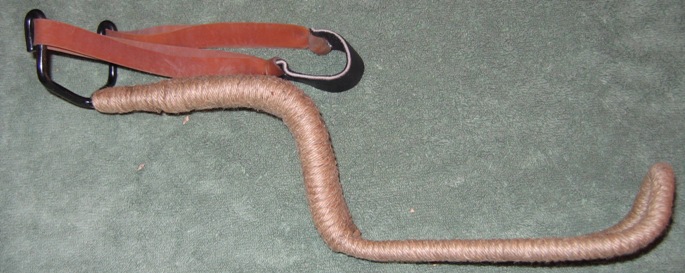
The Nightstalker was sold in the 80's by "Lighthouse Marketing" from Las Vegas. It was an excessively powerful slingshot, with a fork extension and very strong bands that had a pull of about 50 lbs. Of course, the old rule that extreme designs have extreme disadvantages came into play - only very strong people could handle this slingshot, and the metal frame started to bend under the forces that rested upon it.

The famous Pocket-Rocket is the forefather of all wristbraced folding slingshots. The wristbrace is made of leather and the handle is some marbilized plastic, screwed to the frame which runs completely through the handle and holds the wristbrace in place. The bands are attached with the "chinese handcuff" method, while the leather pouch is attached by the "loop through itself-"way, just like it is the case with 95% of all modern slingshots. This classic has inspired almost every recent manufacturer!

General Sports out of Lawrenceburg, Indiana produced this famous slingshot. The pistol-grip style frame is made of polished cast aluminium. The flat bands made of natural gum rubber are attached by the "match in loop"-method, the pouch is held in place by loops through holes in the bands (which is not so good for the band life). The little tube on top of the frame was meant to form a sight, so it is not intentioned to be shot in a 90 degree angle. The whole setup was sold with,according to the advertisement, "deteriorating pellets that literally explode when they hit" - probably clay ammo- and a shooting manual. The Scope-Shot proved to be a very popular slingshot back in its days.
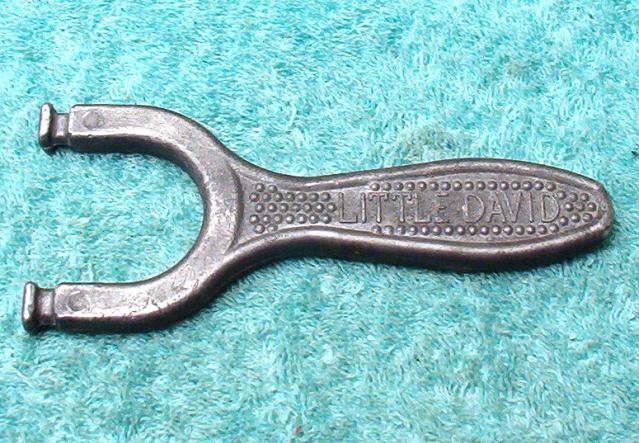
The "Little David" is a small pocket slingshot that was made from cast metal.
From the very beginning on, the Wham-O Sportsman was
a highly
successful slingshot. Its hard to say what made it stand out from the
crowd - it was said to have used very good rubber, but maybe its
commercial success had more to do with marketing than with its shooting
capabilities. Anyway, many manufacturers tried to jump on the bandwagon
and sell their own interpretation of the WhamO. These "Whamo Clones"
all use some type of gum rubber flat bands that are connected to the
frame using two vertical slots in the fork ends. They more or less copy
the frame that can be held both by finger support and pistol grip, and
has a beefy middle area to provide a large saftey margin against
breaking. I think the wooden fork lent itself to be copied with basic
woodworking equipment, this might be another reason why so many
WhamO-wannabees exist.
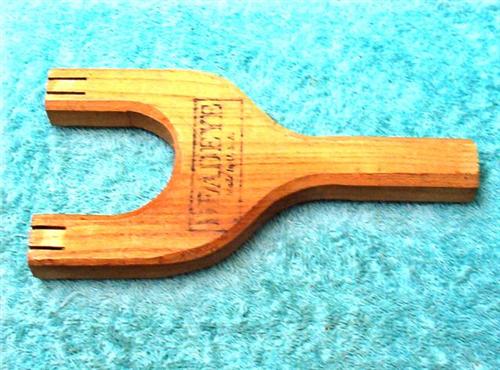
Deadeye
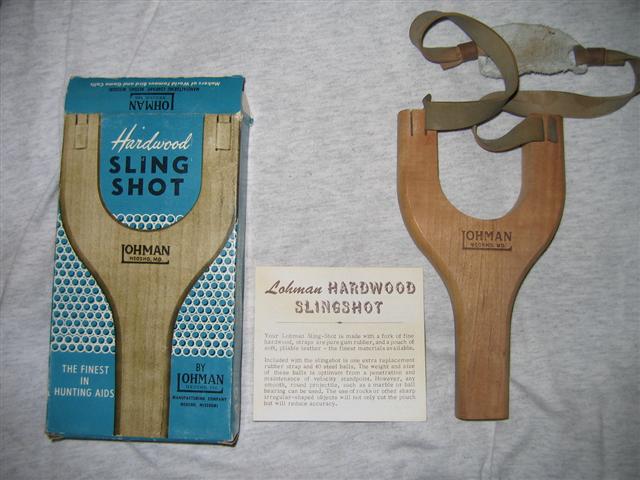
Lohman

Bullseye
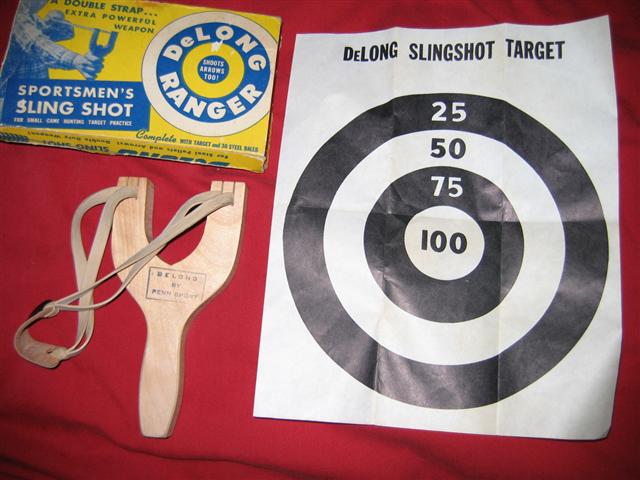
Delong Ranger, first version
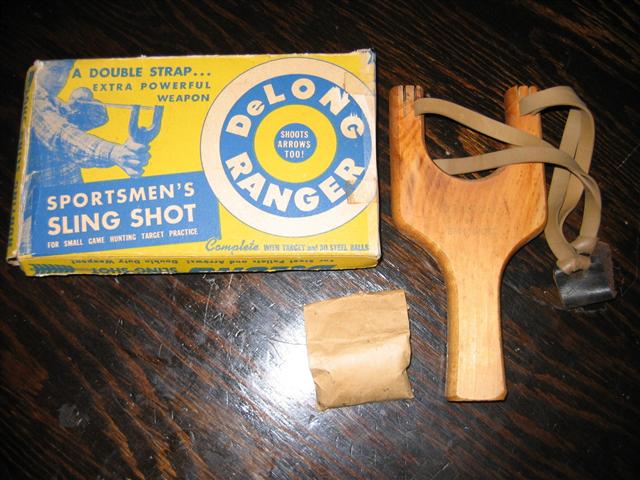
Delong Ranger, second version
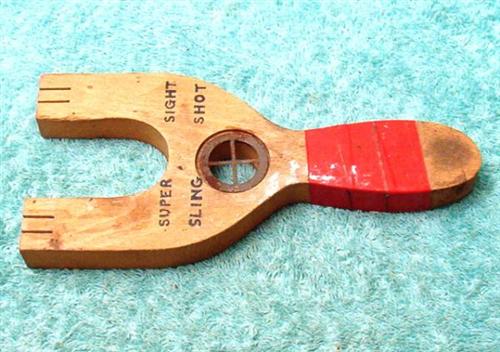
Super Sight
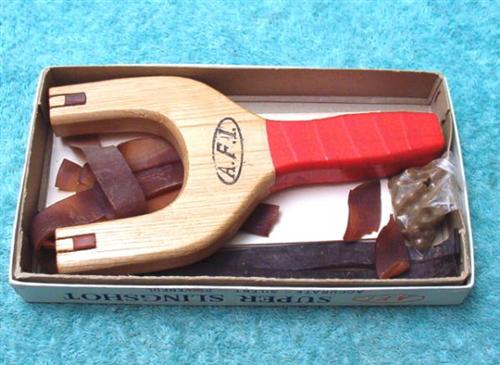
AFI Super
...as well as the "NFI", Thoresen "Extra Power", ASI, "Heavy Duty", Fireball, POW, you name it.. .here is an ad collage that shows a few of the clones, along with the real thing:
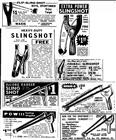
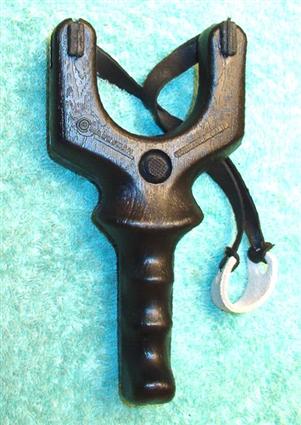
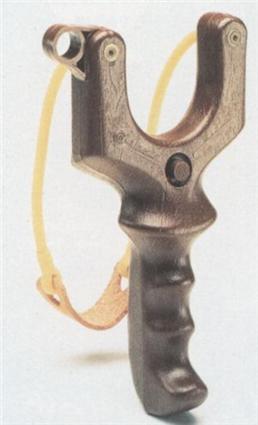
The Marksman "Fireball" was an all-plastic slingshot. It had an ammo storage that released a steel ball when the button on the front was pressed. Its handle had an unusual shape with a thick part that was meant to be supported by thumb and index finger. I have a "Fireball", and so far never found any shooter who liked the Fireball's grip. Marksman produced two versions of this slingshot. One - probably the earlier model - accepted flat bands that were held in place by studs that were molded on the rear side. The second versions uses tubular bands. Both versions have a round (rather useless) peep sight that can be installed on either side of the fork.

Can you believe it? Marksman once sold this huge extended-fork slingshot. It shares handle and Wristbrace with the model 3040, but has a very long fork, made of stronger steel than today's marksman models use.
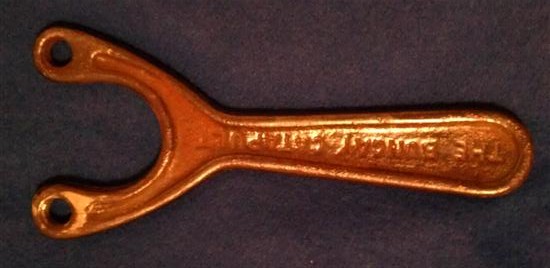
This UK made slingshot looks quite similar to the famous Milbro, but is smaller. Its handle reads "The Bungay Catapult".
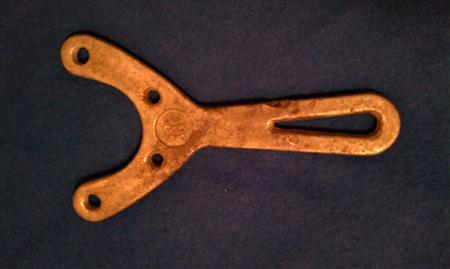
A cast metal slingshot that was made in England. The slingshot used one long rubber band that was laced through the four holes and was connected to both sides of the leather pouch, being pulled towards the shooter from the upper holes in the frame.
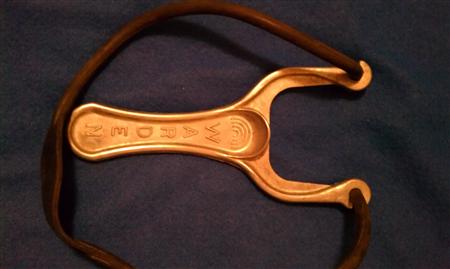
This nice cast aluminum slingshot has a deep groove for thumb support.
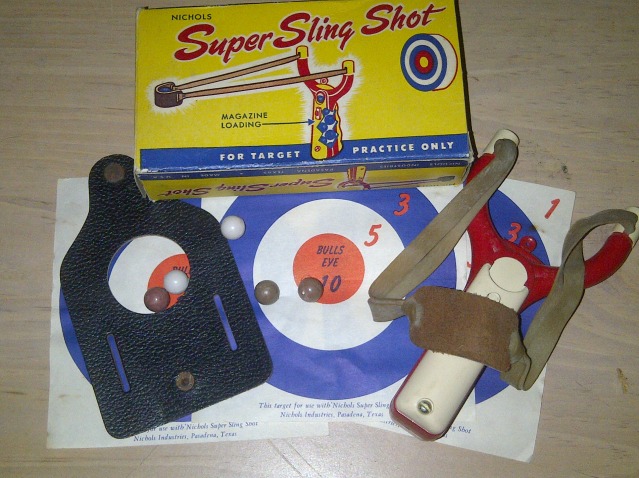
The "Super Sling Shot" is - unusual for the 50s - an
all-plastic
slingshot that has an internal magazine. It used dual flat gum rubber
bands. Its was supplied with ammunition of quite a large diameter, a
leather holster and targets. Note that its box reads "For target use
only", which is quite remarkable. All other slingshots from the 50s
tried to convince the buyer of their unbelievable power and hunting
capabilities.
Link to patent
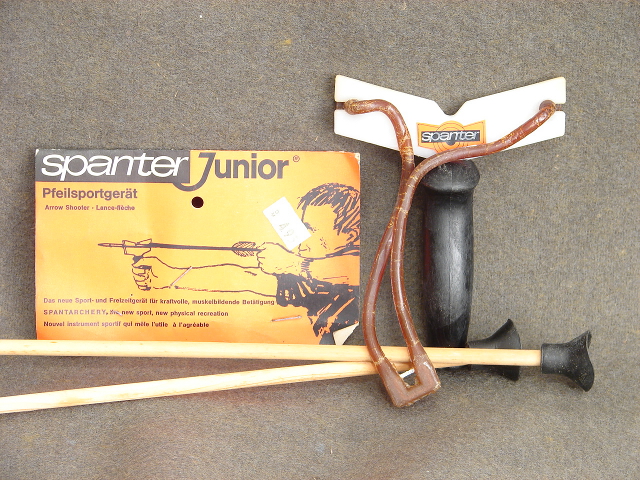
The "Spanter Junior" is a purebred arrow-shooting slingshot. Its one-piece rubber band has a small length of string molded in to hold the nock of an arrow, and the plastic fork has a notch to guide the arrow's shaft. It came with two pretty short suction-cup arrows and a paper target. Production took place in Western Germany.